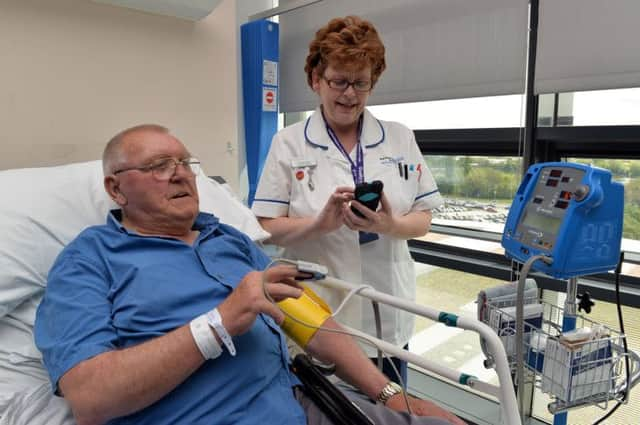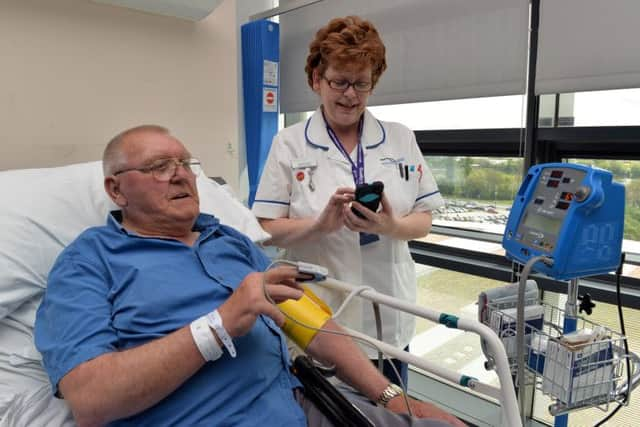VIDEO: New hospital technology will help save lives


New solutions are being found to drive up efficacy and efficiency in every sector and healthcare is no exception.
That is why forward-thinking bosses at Sherwood Forest Hospitals NHS Foundation Trust have embraced a new hi-tech system that is set to revolutionise patient safety - and reduce mortality rates - at King’s Mill Hospital, simply by using technology that many people are more than familiar with today.
Advertisement
Hide AdAdvertisement
Hide AdThe trust is the first in the Midlands to adopt the ‘VitalPAC’ system, which replaces the paper charts that hang on the end of a patients’ bed by enabling clinicians to record information about a patient’s condition on handheld iPod devices for instant analysis.


“It’s a system where instead of nurses and healthcare assistants recording observation on paper charts as is tradition, we record obs onto a handheld device and then we upload that information to the system through the wireless network,” said Morgan Thanigasalam, the trust’s VitalPAC project manager.
“Then that information can be automatically analysed, automatically communicated and remotely accessed by clinicians wherever they may be.”
The essentials of a nurse taking patient observations are exactly the same as before.
Advertisement
Hide AdAdvertisement
Hide AdThey still check a patient’s heart rate, respiratory rate, temperature, blood pressure and other vital signs, but instead of writing the results on a chart, they input them onto the handheld device and any areas of concern are instantly highlighted.
Charts are drawn up by the programme which clinicians can view on iPad-style devices that doctors use on their ward rounds and time is saved trying to locate and analyse paperwork.
The appropriate doctor will be made aware of any concerns from unusual readings by an alert on their own handheld device and actions can then be swiftly taken to ensure the patient is getting the treatment needed - and potentially save lives.
“From a patient perspective, they are getting a tailored plan because it analyses their scores,” said Morgan.
Advertisement
Hide AdAdvertisement
Hide Ad“It tells outreach and critical care staff how their patient is without them being on the ward and allows them to be more proactive and have a broader view of what’s going on.”
According to studies, the fact that VitalPAC analyses the observations, flags up areas of concern and prompts staff to do checks, means that the possibility of human error in calculating scores and making a judgement call about a patient’s condition is reduced three-fold.
It is also about 40 per cent quicker for nurses to complete a set of obs and calculate scores than using the pen and paper method, freeing them up to concentrate on other tasks.
Ward 51 was the first to use the system and healthcare assistant Beverley Boyle said despite initial doubts, it is ‘100 per cent better’ than the old way of doing things because staff can react more quickly to signs of a patient deteriorating.
Advertisement
Hide AdAdvertisement
Hide AdShe said: “I was not that happy about having these machines because I am not very well up in the technology stakes - I don’t like computers.
“But I shocked myself and the ward because I got used to it so quickly and it’s so easy and now they can’t get the devices off me! It’s fantastic.”
The ward’s deputy sister Michelle McPhee agreed that staff have taken really well to using VitalPAC.
“It enables us and the doctors to act on patients’ conditions a lot quicker and it highlights things so there’s less room for error,” she added.
Advertisement
Hide AdAdvertisement
Hide AdIn addition to regular observations, VitalPAC allows data about a patient from other hospital departments to be pulled in and analysed, such as pathology and radiology results, giving an even clearer picture of their condition so appropriate action can be taken.
It will issue alerts for abnormal blood results and problems such as kidney injury and sepsis symptoms, again potentially saving lives through quick responses.
Five wards at King’s Mill have already gone paper chart-free since the introduction of the system, with another four to follow suit by the end of the week.
Morgan said: “We train the clinical staff in a clinical setting and make sure they can use the system in that setting up to the point where we are happy they are using it properly and we can remove the paper charts.”
By the end of July, the team of five trainers will have every ward using VitalPAC - and hopefully patients will be able to see the difference in their care.